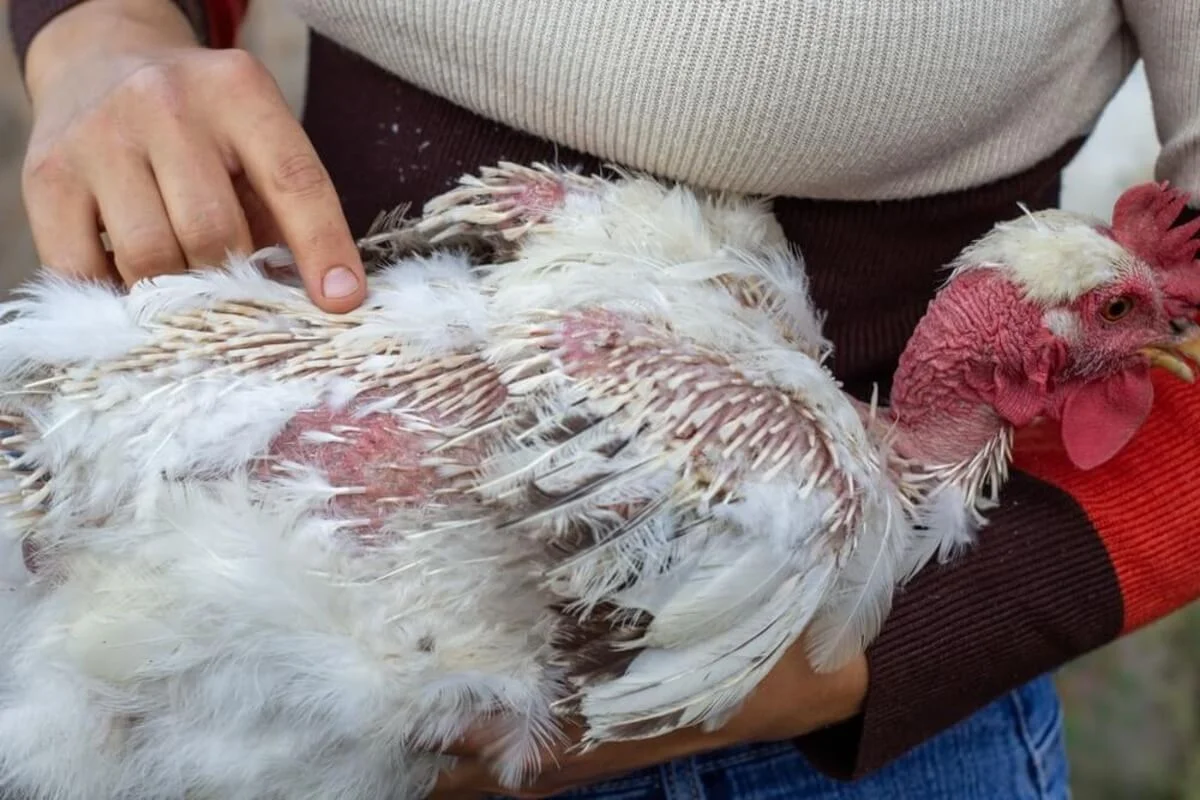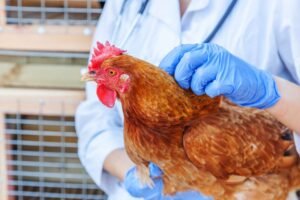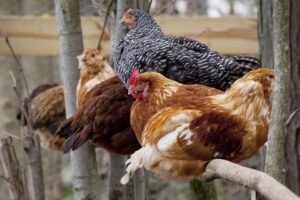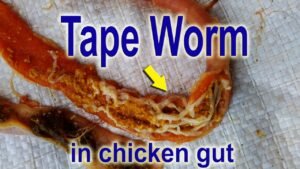The first time you see a chicken molt, it’s easy to panic. Your once-beautiful hen might look like a half-plucked, grumpy porcupine. The coop is suddenly covered in feathers, and her egg production has come to a screeching halt. Don’t worry—this shocking transformation is a normal, healthy, and necessary annual process. It’s simply your chicken’s way of getting a fresh start.
Molting is the natural shedding of old, damaged feathers to grow a new, healthy set for the upcoming winter. This guide will walk you through everything you need to know, from identifying a molt and understanding the timeline to a deep dive into the best foods and crucial stress-reduction tips. By the end, you’ll be able to help your flock get through this awkward phase quickly and safely.
What is Chicken Molting? The “Why” Behind the Feathers
Molting is a vital biological process that serves a single, crucial purpose: to replace old, worn-out feathers with a brand-new set that provides superior insulation and protection against the cold. It’s primarily triggered by decreasing daylight hours in the late summer and fall, which signals to the chicken that it’s time to prepare for winter.
The Science of Molting
The process is controlled by a chicken’s hormones, specifically a decrease in estrogen (which is what stops egg production) and an increase in thyroid hormone. When daylight hours drop below a critical threshold (typically around 10-12 hours), the hormonal shift begins. This is why molting is so predictable and happens around the same time each year.
Feathers are made of about 85% keratin, a protein. This means growing a new set of feathers is like running a marathon for your chicken’s body, requiring a massive amount of protein and energy. Understanding this single biological fact is the key to providing the right kind of support.
The Two Types of Molt
- Soft Molt: This is a gradual process where a chicken loses feathers over a longer period, sometimes so slowly that you barely notice it. Egg production may slow down but not stop completely. This is common in backyard flocks with good genetics and low stress.
- Hard Molt: A hard molt is a rapid, dramatic feather loss. A hen can go from fully feathered to looking almost bald in a matter of days. This type of molt is more stressful for the chicken but is over more quickly, usually within 4-6 weeks. It is often seen in high-producing breeds that have put a lot of energy into egg-laying.
Do Roosters Molt?
Yes, roosters molt just like hens do. While they won’t stop laying eggs, you will notice a significant change in their appearance as they shed old feathers and grow a new set, including a new set of tail feathers. They may also be more irritable and less interested in mating during this time.
Understanding the “why” behind molting helps you see it as a natural, healthy process, not a sign of sickness. Knowing what to look for next will help you rule out other, more serious issues.
Molting Symptoms vs. Illness: How to Tell the Difference
This is the most important section for a worried owner. Knowing the difference between a normal molt and signs of illness can prevent a lot of unnecessary panic.
Key Signs of a Normal Molt
- Symmetrical feather loss: A normal molt typically starts at the head and neck and moves down the body in a predictable pattern. You’ll see feathers falling out evenly from both sides.
- The appearance of new pin feathers: These look like little plastic quills and are the new feathers growing in. They are a definitive sign of a healthy molt.
- A significant drop or complete stop in egg-laying: A chicken’s body can’t produce both feathers and eggs at the same time, so egg production will almost always stop.
- Increased appetite but possibly a grumpier-than-usual attitude.
Could It Be Mites or Lice Instead?
This simple table can help you differentiate between the two:
| Symptom | Molting | Mites/Lice |
|---|---|---|
| Feather Loss | Symmetrical, predictable pattern | Patchy, random, and often concentrated around the vent, neck, or tail. |
| Skin Condition | Healthy, normal skin underneath | irritated, red, scaly skin; you might see small black specks (mite droppings) or white eggs on the feathers. |
| New Feather Growth | Visible pin feathers | No new feather growth, or it may be stunted or damaged. |
| Chicken’s Behavior | Grumpy, but otherwise active | Excessive scratching, pecking, and restlessness due to the irritation. |
When to Be Concerned: Signs That Are NOT a Normal Molt
While a molting chicken looks rough, a truly sick chicken will have other symptoms that have nothing to do with feather loss. Call a vet immediately if you see any of these signs:
- Lethargy or weakness: The chicken is not just quiet; she is hunched, eyes closed, and unwilling to move.
- Bloody or unusually watery droppings: This can be a sign of parasites or a severe infection.
- Swelling or discharge around the eyes or nostrils.
- Respiratory issues: Gurgling, sneezing, or a rattling sound when she breathes.
- Inability to stand or walk: This can signal a severe illness or injury.
Once you’ve ruled out illness, you can confidently address the next steps. Now let’s talk about when to expect the process to begin and how long it will last.
The Molting Timeline: When It Happens and How Long It Lasts
When Do Chickens Molt?
Adult chickens (over 18 months old) typically molt once a year, usually in the late summer or fall. It is a natural response to the decrease in daylight hours. A hen’s first molt is often lighter than subsequent ones.
How Long Does Molting Usually Last?
The process can last anywhere from 4 to 12 weeks. A “hard molt” is more dramatic but over with more quickly. A “soft molt” is slower, with fewer feathers being shed at a time, making it less noticeable.
Why Is Only One of My Chickens Molting?
Molting is an individual process. Each chicken is on its own unique schedule based on its age, breed, and health. Some will molt early, some late, and some might even skip a year. Just because one is molting doesn’t mean the whole flock will follow suit immediately.
Factors That Affect the Molt
- Age: Younger chickens (under 18 months) may have a lighter molt or not molt at all.
- Breed: High-producing commercial egg layers tend to have a shorter, more dramatic molt as they’ve used so much energy on egg production. Backyard breeds may have a slower, softer molt.
- Diet: A poor diet can lead to a long, drawn-out molt because the chicken doesn’t have the nutrients to regrow feathers quickly.
- Stress: High stress from heat, predators, or moving can trigger an untimely or more severe molt.
- Artificial Lighting: Some chicken keepers use artificial light to keep hens laying through winter. This can disrupt the natural hormonal cycle and affect the timing of the molt.
Now that you know what to expect and when, the next critical step is to give your chickens the nutritional support they need to get through this process as quickly and painlessly as possible.
What to Feed Molting Chickens: A High-Protein Diet is Key
Do Chickens Need Extra Protein When Molting?
Yes, absolutely. Because feathers are about 85% protein, their regular layer feed (usually 16% protein) is not enough to support the massive energy demands of regrowing a new set of feathers. You must supplement their diet.
The Best Feed for Molting Chickens
Temporarily switch their primary feed to a higher protein formula. Look for a “Feather Fixer” feed or even a chick starter/grower feed, which usually contains 20-22% protein. This higher protein content gives their body the amino acids they need to produce keratin.
Top High-Protein Treats for Molting Chickens
Add these treats to their diet to give them the necessary building blocks for new feathers.
- Black Soldier Fly Larvae or Mealworms: These are packed with protein and a great source of calcium.
- Scrambled Eggs: A natural, high-protein powerhouse that is easy for them to digest.
- Fish Meal: Can be mixed into their regular feed for a substantial protein boost.
- Sunflower Seeds: Especially black oil sunflower seeds, which are high in both protein and healthy fats.
- Cooked Lentils or Beans: A very cost-effective and nutrient-dense protein source.
- Plain Yogurt: The probiotics are great for their gut health, and it’s another good source of protein.
The Importance of Water
While protein is critical for feather growth, water is non-negotiable. Dehydration will stop the molting process dead in its tracks. Ensure your flock has constant access to fresh, clean water at all times.
What Happens If You Feed Chickens Too Much Protein?
It’s important to remember that this high-protein diet is a temporary boost for the molting period only. Once your chicken has regrown her feathers, you should switch her back to her regular layer feed. Long-term excess protein can cause kidney issues and other health problems.
Feeding your chickens a protein-rich diet will significantly speed up their recovery. But there’s more you can do to support them. Let’s move on to the other ways you can help them feel safe and comfortable.
How to Help Your Chickens During Molting (Beyond Food)
Minimize Stress
Molting is already a stressful process for a chicken. A stressed bird will have a harder time molting and can be more susceptible to illness. Avoid adding any new birds to the flock, and don’t make any major changes to the coop layout during this vulnerable time. Keep a consistent routine, and ensure they have a safe, quiet space to rest.
Avoid Handling
The emerging pin feathers are a chicken’s equivalent of a new tooth—they are connected to blood vessels and are incredibly sensitive and painful if touched or damaged. Handle your chickens only when absolutely necessary during this time. A damaged pin feather can even cause bleeding.
Helpful Herbs and Supplements
Consider adding a balanced poultry vitamin supplement to their water to ensure they are getting all the necessary nutrients. Oregano is a natural antibiotic and immune booster. Parsley is rich in vitamins and minerals. And garlic is a natural immune booster and can be crushed and added to their water or feed.
Protecting a Bare Chicken in the Cold
If a chicken is molting late and the weather is getting cold, you can provide extra warmth in the coop. Ensure the coop is well-ventilated but draft-free. You can also hang a ceramic heat emitter (not a heat lamp, as they need to sleep in the dark) or a radiant heater to keep the temperature comfortable, especially at night.
Coop & Biosecurity Tips
- Cleanliness: The coop will be a mess with feathers. To prevent the spread of parasites and disease, clean out old bedding and replace it with fresh, clean bedding.
- Pest Control: Molting chickens are more vulnerable. Ensure your coop is secure against pests and predators.
By providing this extra care, you’ll ensure your flock is not only well-fed but also secure and comfortable throughout the molting process. Now, let’s answer some common questions to round out the guide.
Frequently Asked Questions (FAQ)
Q: Do chickens lay eggs when molting?
A: No, almost never. A chicken’s body must choose where to direct its protein resources. Feather regrowth takes priority over egg production, so you can expect a pause in laying. The hen’s body is smart and knows it needs to be ready for winter.
Q: Is my chicken in pain while molting?
A: Molting is an uncomfortable and itchy process, especially as the new pin feathers grow in. However, it is not a painful illness. The pain comes from handling or damaging the sensitive pin feathers.
Q: Do chickens eat less when molting?
A: Some might temporarily, but most will have an increased appetite due to the high energy and protein demands. You will likely see them eating more than usual.
Q: What vitamins do chickens need when molting?
A: A balanced poultry vitamin supplement is best, but key nutrients include B vitamins, amino acids like methionine, and calcium (even if not laying, they need it for bone health).
Conclusion: A Healthy Molt Means a Healthy Winter Flock
Molting can look alarming, but it’s a natural and necessary part of a chicken’s life. Your job is to make the process as smooth as possible by understanding the signs, prioritizing protein, and reducing stress. By providing the right support, you can help your flock get through this awkward phase quickly and emerge with a beautiful, dense set of feathers, perfectly ready for winter.

Oladepo Babatunde is the founder of ChickenStarter.com. He is a backyard chicken keeper and educator who specializes in helping beginners raise healthy flocks, particularly in warm climates. His expertise comes from years of hands-on experience building coops, treating common chicken ailments, and solving flock management issues. His own happy hens are a testament to his methods, laying 25-30 eggs weekly.



